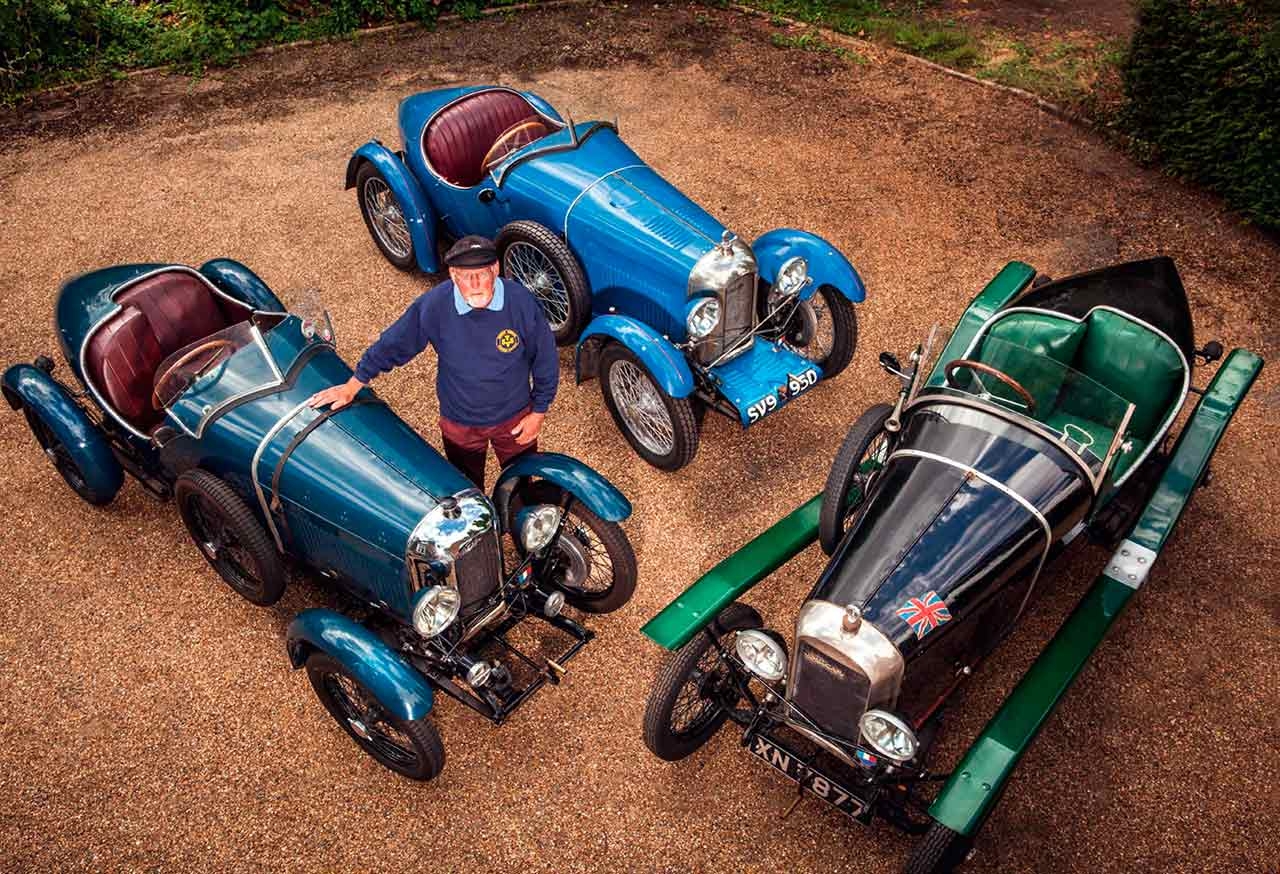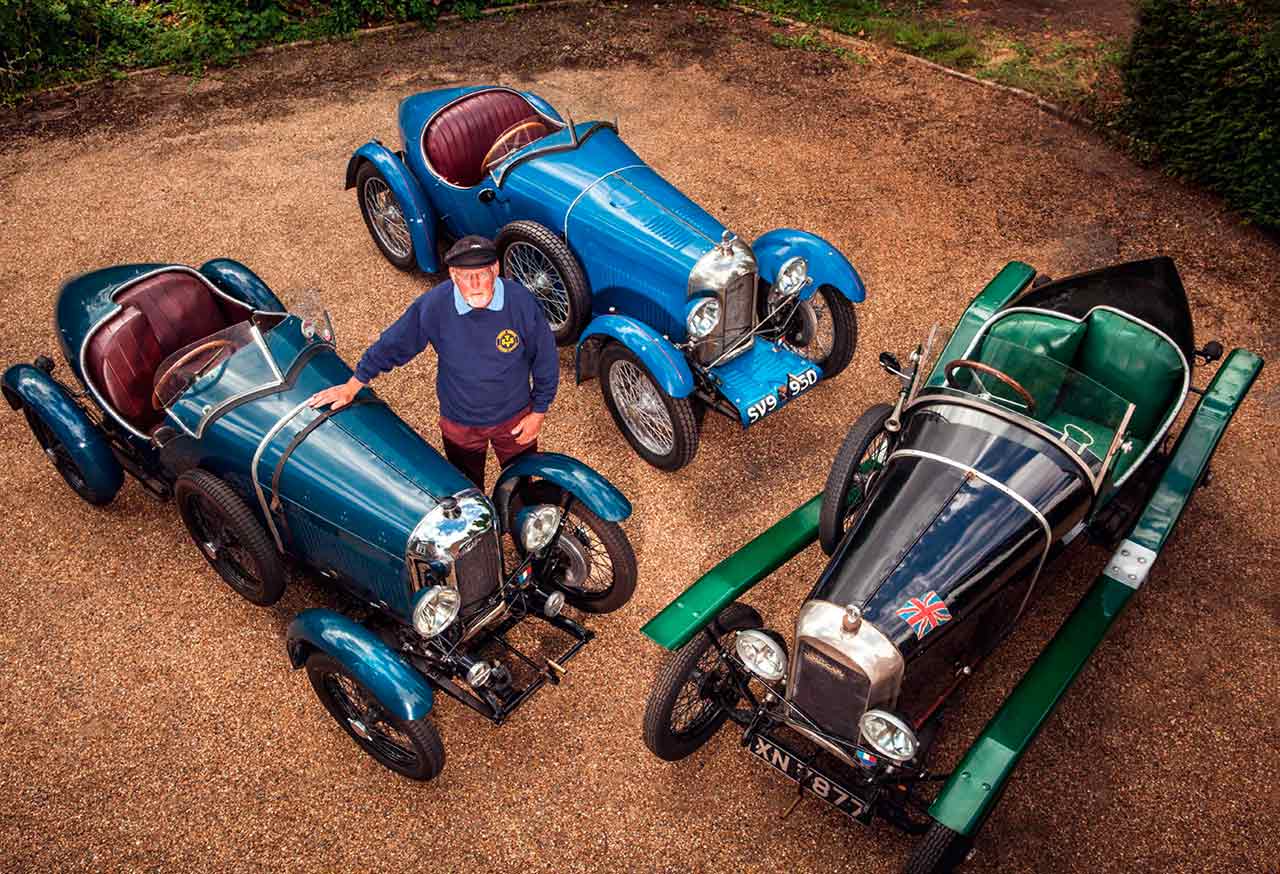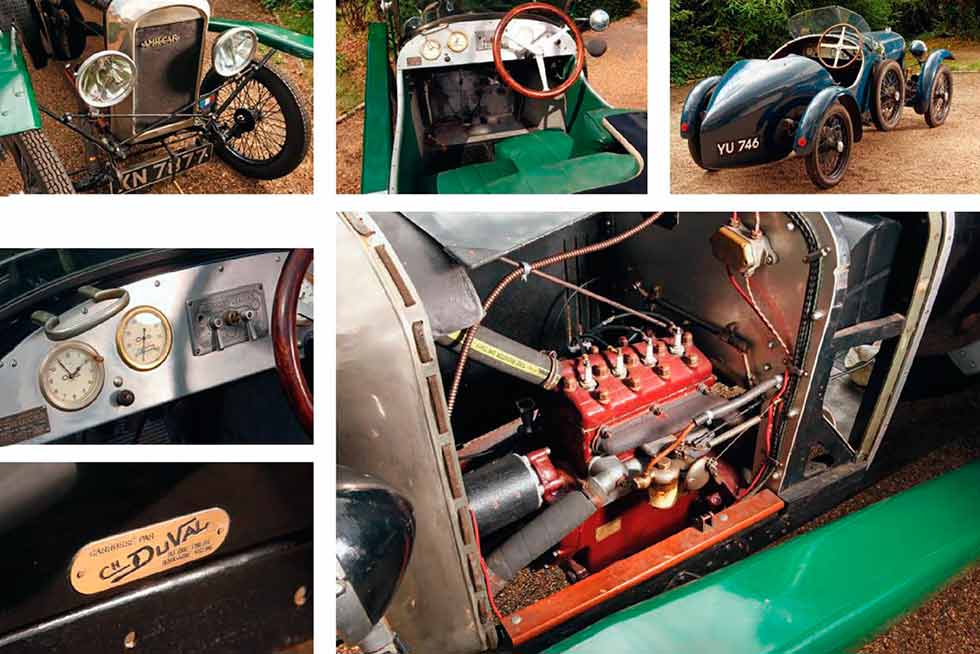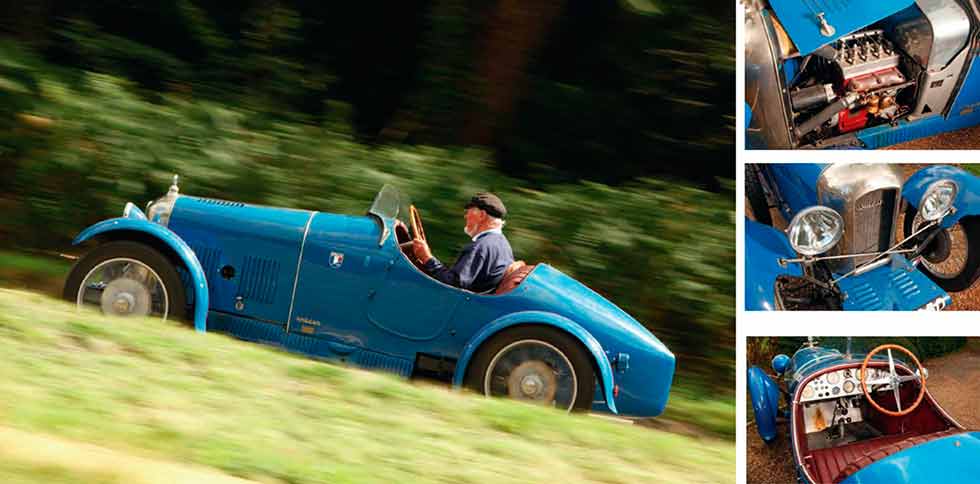
An Amilcar aficionado. Sixty years with the French voiturette. Desmond Peacock has been driving Amilcars since 1955. Jon Pressnell takes a tour of his collection of these delightful vintage French sports cars. Photography Tony Baker.
Long-term Love affair Drive-My meets the enthusiast who has been enjoying Amilcars since 1955
In France, the Amilcar sports car of the 1920s is every bit as emblematic and sought-after as the Type 35 Bugatti. Slender, elegant and blessed with a fine competition heritage, it has a strong following and equally robust prices; as with the Bugatti, there are fair numbers of cars that have been built up subsequently, using reproduction parts. But whereas the Bugatti is an international phenomenon, the Amilcar has ended up an almost exclusively French thing – even if it was the British who set up the first Amilcar club, back in the 1960s.

Among those individualists and Francophiles who form the exception to this picture, one of the foremost is Desmond Peacock. Having owned examples of the make continuously since 1955, he can reasonably be considered Britain’s ‘Mr Amilcar’. Today Peacock has three sports Amilcars, covering the 1923 to ’1929 golden years of the marque. Along the way, he’s owned half a dozen others, including one of the much-prized six-cylinder racers and a bigger 1878cc J-type. But the Amilcars we are talking of here are the lightweight 903cc to 1074cc models, from the original type CC through to the final CGSS – cars born of France’s short-lived cyclecar boom.
This was brought about by a new taxation class being established in 1920, for cars with no more than two seats, weighing a maximum of 350kg (excluding lights, tools, spare wheel and fluids), and having an engine of under 1100cc. Helped by an economic recovery, the 1921 Paris motor show featured no fewer than 31 makes of cyclecar.
From just 814 examples registered in 1920, the number on the roads would jump to 9621 in 1922 and to a heady 20,426 in ’1923, in which year there were 96 cyclecar manufacturers in France. There were two schools of design: something closer to a motorcycle on one hand, and something more like an orthodox car on the other – although often omitting the differential to save weight. The first Amilcars fell into the latter category. Inevitably they soon became bigger and more sophisticated, meaning that they moved up to the next taxation class, for small cars or voiturettes. Indeed, just having a third seat would push a vehicle into this tax bracket. Helping this move upmarket, in 1924 the duty for cyclecars was raised and that for voiturettes lowered, a year before the cyclecar class was abandoned.
The first Amilcar was the two-seater CC, with a 903cc engine. Current for the ’1922 through to ’1925 model years, it was joined for 1923 by the C4, which had a 1004cc unit, a longer and more rigid chassis, improved brakes and a forged steel rather than wooden front axle. Catalogued until 1929, and available with a variety of bodies, some four-seater, the C4 gained a differential in 1925 and front-wheel brakes for ’1929. The first sports model had arrived for the ’1923 season, in the form of the CS or ‘Cyclecar Sport’. This was joined for 1924 by the 1074cc CGS or ‘Cyclecar Grand Sport’, which, as well as a bigger and more robust engine, had front brakes and a semi-elliptic rather than quarter-elliptic front end. Successful in French competition events, the CGS could be specified with an ‘Eldridge’ radiator cowl, similar to that found on early C-type MGs.
The final sporting model was the CGSS, for ‘Châssis Grand Sport Surbaissé’ – in other words, a CGS with lowered suspension. Replacing the CGS, it had sundry mechanical improvements, not least bigger brakes and a better steering box, and was said to be good for 75mph. Used by many owners as a road car during the week and for competition at weekends, the rakish CGSS became the definitive Amilcar, and was regarded as a stepping stone to, say, a Type 37 Bugatti. It was a 1927 CGSS, the dark blue car in our photos, which in 1955 was Desmond Peacock’s first Amilcar, bought for £55: “I’d always wanted one, from when I was at school. I used to play cricket at The Tiffin School in Kingston and there was one in the car park. I put an ad in Motor Sport and got offered all sorts of things. Eventually I did a deal at the kerbside for the CGSS.”
After an interlude with a six-cylinder racer, Peacock’s next purchase was more modest: the dismantled remains of the black 1923 CS. “It had been a CC with a touring body,” he recalls. “That had disappeared, so I had to have a body made, and a set of wings. Meanwhile, I was keeping an eye open for missing parts, such as the gauges. A ’screen turned up in France. That was the most difficult bit to track down. The instruments were fairly easy, unlike the light switch. It’s original – that’s why it took some time finding. The amount of money that cost – and a right box of tricks they are! It was about 1990 when I put it all together. I did it almost like a Meccano kit.”
An early 1922-season CC briefly joined the stable: “It was lethal. I don’t know how the previous owner ever drove it – it was so original that everything was worn out.” Still part-owned by Peacock is an example of the J-type, a 1.9-litre development of the 1½-litre E-type with which Amilcar tried to break into the next 10CV/11CV market: “It was as if they had designed the car by taking a pantograph to the small version. It never sold very well, and quite a lot of them turned up in Australia, where this one was found. I think they sent them as far away as possible. It’s quite a heavy thing – everything weighs a lot.”
The final of Peacock’s current Amilcars is a 1929 CGSS bought about five years ago: “Everybody wants a CGSS. These are the ones being built from scratch, particularly in France and Switzerland, mainly from G-type and M-type saloons and tourers. These used the same basic engine. The ‘G’ unit was the same as that in the GS, and then they lengthened the stroke. Then they did it again, for the M-type. That last 1244cc engine is popular – use that, and you get quite a quick car. The M-type chassis is wider and much heavier, so you can’t use that, but someone in the South of France is making new chassis. With cars changing hands at around £50,000, it’s hardly surprising that this sort of thing goes on…”
The mechanical components of Peacock’s current trio are largely the same – with, naturally enough, some key improvements over the years. The side-valve engine is a two-main-bearing unit: “If they’re pushed, the cranks do let go. The pressure-fed ones are safe to about 4000rpm. Go above that, and you’re probably in trouble. But then J2 MGs are notorious for breaking their cranks. They’ll go on for years, if driven quietly and sensibly. I’ve certainly never broken one. With modern materials, though, the sky is the limit – for example with a Phoenix crank.”
Another shared feature is a wet clutch, with metal plates and using the same oil as the engine: “It’s prone to slipping and difficult to engage when the engine is cold. With two driven plates and one slave plate in between, there are four contact surfaces, so when the oil is thick you have problems.” Peacock acknowledges that this is a weak point: “When everything is new, it might be fine, but it’s a bit different when it’s 80 years old and things are worn and get out of line.”
The steering, by worm and sector, is another challenge, says Peacock: “They beefed up the box twice, but you still get the old worm problem, where the sector wears in the middle, at the straight-ahead position. In fact, it’s a thoroughly bad design, because of the transverse drag link that’s used.” In compensation, the braking system advanced hugely with the arrival of Amilcar’s patented and ingenious rod-operated front-wheel brakes, bringing with them better location of the front axle by semi-elliptics, to resist torque wind-up under application: “It makes a hell of a difference, but you lose a bit of steering lock.”
Bodies were mainly by Charles Duval – even after Amilcar set up an in-house shop in 1926. Chassis were also sold in fair numbers to outside coachbuilders, while assembly of Amilcars under licence took place in Austria and Italy. The quality of the Duval bodies is good, says Peacock: “They seem to have lasted pretty well. All the joints are mortise and tenon and there are tacks through the joints to stop the body fretting.”
Peacock’s 1923 CS carries a reproduction Duval body in aluminium. Clearly older, and less sleek, the CS has sweeping one-piece flat-top wings, a higher tail, a radiator that is less cowled, and a single-piece factory ’screen: “A lot of people went to outside windscreen makers, just for the sake of being able to put a hood on the car – and if you wanted a flared scuttle, you specified it.” Mechanically, this is the sports Amilcar at its most basic. There’s no differential, of course, nor front brakes – the front axle is armoured wood – and the 1004cc engine is splash-fed. There are, however, friction dampers all round as standard, whereas on the first cars these were optional.
The lightest by some margin of the three cars, the CS acquits itself well on the road. It feels quite sprightly, and manages to pull away from near-standstill in second. In this middle gear there’s a typically coffee-grinder soundtrack, but drop into top and the car is sweet and relaxed at 25-30mph. You just have to make sure that you don’t change up to third too quickly, or else the engine dies. Once rolling, the CS pulls well in top at over 30mph and will cruise at 40-45mph on the open road, climbing gentle hills without complaint. For extra oomph, there’s an exhaust cut-out. Operate the lever, and you feel the difference. It’s worth about ½bhp, says Peacock.
Once the oil is warm, the clutch is impressively light and smooth, and gearchanging via the little knitting-needle of a lever can be swift and clash-free in the expert hands of Peacock, who admits that he used to drive without the clutch once on the move – “just for the exercise”. The long-travel brakes are a different matter, needing a shove. In all this, you should not expect much comfort. There’s a jittery, stomach-bashing ride, and the CS bucks about on poor surfaces. “The earlier cars are more skittish, and then there’s the lack of a differential,” says Peacock. “The more you turn the wheel the harder the steering gets, because of the scrubbing. But it’s a good little beast – the least fussy of all of them.” Peacock rates the ’1927 CGSS as the most fun to drive. Its pressure-fed 1074cc unit is more sparkling, it rides less abruptly – but still firmly – and it has notably effective stopping power. “The brakes are phenomenal,” he says. “I don’t know what I’ve done but I must have done it right. On the Tapley meter it took the MoT inspector right out of his seat. I don’t touch them now.”
The later CGSS – steel-bodied, as the ’1927 car – is an altogether more mature device. Not only does it have a later 1244cc engine, but it has the matching four-speed gearbox. It also has wider wheels, a diff-equipped rear axle, plus the larger body with side-by-side seating (and two doors) that was introduced for the final ’1929 model year. The car feels more refined – less zippy, yes, but pulling much more strongly, especially from low speeds in third. It accelerates up hills with real assurance, and is contented at 45-50mph.
The ride is less jarring but still sharp, and the steering lighter – although it stiffens as you put on the lock and needs wrenching round corners. The gearchange can be obstructive, and finding one’s way around the gate is not always obvious. The clutch is firmer, too, while the brakes lack the edge of those on the ’1927 CGSS – something Peacock attributes to the later car’s extra weight. All three demand a certain knack to drive, especially until warm, and, with the exception of the ’1929 car, they are not built for large people. But they give a zingy performance – the late car less so – and have the virtues of light weight and good looks. You can see why they appeal, even against well-regarded rivals such as the contemporary Salmsons, and why Peacock has been an enthusiast for nearly 60 years.
“You’re either a Salmson man or an Amilcar man,” he says. “Salmsons are bigger all-round, and have a much better engine, but I don’t find them as endearing as the Amilcars.”
Thanks to Tony Russell and Bryan Goodman of Surrey Vintage Vehicle Society: www.svvs.org



“I’D WANTED ONE EVER SINCE I WAS AT SCHOOL. I BUILT THIS CS ALMOST LIKE A MECCANO KIT”
‘THE LATER CGSS FEELS MORE REFINED – LESS ZIPPY, BUT PULLING MUCH MORE STRONGLY’





